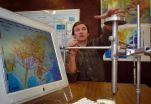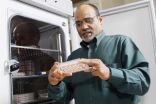(Press-News.org) GAINESVILLE, Fla. — New University of Florida research puts to rest the mystery of where old carbon was stored during the last glacial period. It turns out it ended up in the icy waters of the Southern Ocean near Antarctica.
The findings have implications for modern-day global warming, said Ellen Martin, a UF geological sciences professor and an author of the paper, which is published in this week's journal Nature Geoscience.
"It helps us understand how the carbon cycle works, which is important for understanding future global warming scenarios," she said. "Ultimately, a lot of the carbon dioxide that we're pumping into the atmosphere is going to end up in the ocean. By understanding where that carbon was stored in the past and the pathways it took, we develop a better understanding of how much atmospheric carbon dioxide the oceans can absorb in the future."
Scientists know that during the transition from the last glacial period to the current inter-glacial period about 14,000 years ago, carbon dioxide levels rose very quickly at the same time that the age of the carbon dioxide in the atmosphere fell, as measured by radiocarbon data. That suggests carbon dioxide had been stored in the ocean and suddenly released, she said.
One idea holds that it was building up in the Southern Ocean around Antarctica, where extensive sea ice on the surface of the ocean initially prevented the exchange of gasses into the atmosphere, Martin said. The other possibility is that the same process occurred in the Northern Hemisphere with ice sheets in the North Pacific Ocean, she said.
In her lab, Martin and lead author Chandranath Basak, a UF graduate student in geological sciences; Keiji Horikawa, a UF postdoctoral fellow in geological sciences; and Thomas Marchitto, a University of Colorado geology professor, studied that question by using a technique to measure isotopes of neodymium, a rare earth element not commonly found in marine sediments but preserved in microscopic fossil fish teeth. The isotopic signature of a water mass, which is captured in the fish teeth, reflects the location where the water mass came from, she said.
"It's essentially what we call a water mass tracer," Martin said. "You can tell where the water masses have formed and where they have moved to by using this tracer."
The researchers took samples that had been shown to have old carbon in them and measured the neodymium isotopes on fish teeth from the sediments to see if they could reconstruct whether they had come from the North Pacific or the Southern Ocean, she said.
"When we did this, we got a signal that looks very much like the Southern Ocean," she said. "It implies that all the carbon was being stored in the Southern Hemisphere and as the ice sheet melted back, it released that carbon dioxide into the atmosphere, causing part of the big increase in carbon dioxide and introducing old carbon back into the atmosphere."
By giving information about environmental conditions during the last glacial period, the research findings can help scientists to reconstruct what the world was like at that time, she said.
The implications are that while large amounts of carbon could be stored in the ocean when there was a great deal of sea ice, the opposite is the case in a world that is warming, with less ice, which allows more carbon dioxide to be released into the atmosphere, Martin said. Thus, in a warming scenario the oceans may not be able to store as much carbon dioxide as they could under glacial conditions
The oceans are a critical part of the carbon dioxide cycle, Martin said. "The oceans have 60 times more carbon dioxide in them than the atmosphere, so when we worry about what's happening with carbon dioxide in the atmosphere, we often look to the oceans as a potential source or sink."
The concentration of carbon dioxide in the atmosphere during the glacial periods was about 200 parts per million, compared with 280 parts per million during a typical interglacial period, Martin said. Today that level has soared to about 380 parts per million, she said.
The time period that encompasses the last glacial period to the current interglacial period when carbon dioxide levels went up very quickly is often referred to as the "mystery interval" because scientists hadn't known where the carbon was stored, Martin said.
"Now we have a better understanding of how the system worked," she said.
###
Credits
Writer
Cathy Keen, ckeen@ufl.edu, 352-392-0186
Source
Ellen Martin, eemartin@.ufl.edu, 352-392-2141
WEST LAFAYETTE, Ind. - Researchers found a previously unmapped fault was responsible for the devastating Jan. 12 earthquake in Haiti and that the originally blamed fault remains ready to produce a large earthquake.
Eric Calais, a Purdue University professor of earth and atmospheric sciences, led the team that was the first on the ground in Haiti after the magnitude 7.0 earthquake, which killed more than 200,000 people and left 1.5 million homeless.
The team determined the earthquake's origin is a previously unmapped fault, which they named the LÄogëne fault. The newly ...
CHICAGO, Oct. 25, 2010 – Young children who consume substantial amounts of fluoride through infant formula and other beverages mixed with fluoridated water or by swallowing fluoride toothpaste have an increased chance of developing mild enamel fluorosis, according to research published in the October issue of The Journal of the American Dental Association and supported by the National Institute of Dental and Craniofacial Research. Children can continue using fluoridated water and fluoride toothpaste because fluoride has been proven to prevent tooth decay, and mild fluorosis ...
While most commonly associated with mononucleosis, Epstein-Barr virus (EBV) has been linked to many diseases that affect people long after the initial infection takes place, including some forms of cancer. In the current issue of the Journal of Biological Chemistry, scientists at The Wistar Institute describe how viral microRNA – small segments of RNA that suppress the effects of gene activity – allows EBV to hide within cells and evade the immune system. The scientists believe their findings may one day enable physicians to flush EBV out of hiding, allowing a healthy immune ...
CAMBRIDGE, Mass. -- Researchers at MIT have revealed exactly how a molecule called fulvalene diruthenium, which was discovered in 1996, works to store and release heat on demand. This understanding, reported in a paper published on Oct. 20 in the journal Angewandte Chemie, should make it possible to find similar chemicals based on more abundant, less expensive materials than ruthenium, and this could form the basis of a rechargeable battery to store heat rather than electricity.
The molecule undergoes a structural transformation when it absorbs sunlight, putting it into ...
WEST LAFAYETTE, Ind. - Pathogenic listeria tricks intestinal cells into helping it pass through those cells to make people ill, and, if that doesn't work, the bacteria simply goes around the cells, according to a Purdue University study.
Arun Bhunia, a professor of food science, and Kristin Burkholder, a former Purdue graduate student who is now a postdoctoral researcher in microbiology and immunology at the University of Michigan Medical School, found that listeria, even in low doses, somehow triggers intestinal cells to express a new protein, heat shock protein 60, ...
An international team of researchers based at the Institute of Vertebrate Paleontology and Paleoanthropology in Beijing, including a physical anthropology professor at Washington University in St. Louis, has discovered well-dated human fossils in southern China that markedly change anthropologists perceptions of the emergence of modern humans in the eastern Old World.
The research was published Oct. 25 in the online early edition of the Proceedings of the National Academy of Sciences.
The discovery of early modern human fossil remains in the Zhirendong (Zhiren Cave) ...
BUFFALO, N.Y. -- Scientific and political disputes over drilling Marcellus shale for natural gas have focused primarily on the environmental effects of pumping millions of gallons of water and chemicals deep underground to blast through rocks to release the natural gas.
But University at Buffalo researchers have now found that that process -- called hydraulic fracturing or "fracking"-- also causes uranium that is naturally trapped inside Marcellus shale to be released, raising additional environmental concerns.
The research will be presented at the annual meeting of ...
Ear infections are one of the most common health problems for children, with most kids experiencing at least one by their third birthday. Annual costs in the United States alone are in the billions of dollars.
When these infections are left untreated, complications can include hearing loss, speech problems and more severe infections that can spread to bone and brain, causing meningitis. But not all kids have the same access to medical specialists and medicines.
A new study by researchers at the David Geffen School of Medicine at UCLA and Harvard Medical School has ...
Knowledge gaps and fear — some of it unjustified — are common among the caregivers of children with a drug-resistant staph bacterium known as MRSA, according to the results of a small study from the Johns Hopkins Children Center. These caregivers thirst for timely, detailed and simple information, the researchers add.
The study's findings, published online in The Journal of Pediatrics, underscore the need for healthcare staff to do a better job in educating parents, while also addressing concerns and allaying fears, the investigators say.
"What these results really ...
Madison, WI, October 25, 2010 – A case study published in the 2010 Journal of Natural Resources and Life Sciences Education by professors at Washington State University studies the challenges one organization faced in maintaining an urban market garden. The journal is published by the American Society of Agronomy.
Since 1995, Seattle Youth Garden Works (SYGW) has employed young homeless individuals or those involved in the juvenile justice system. SYGW offers teens and young adults the opportunity to work, develop social skills, and eventually find stable employment or ...


